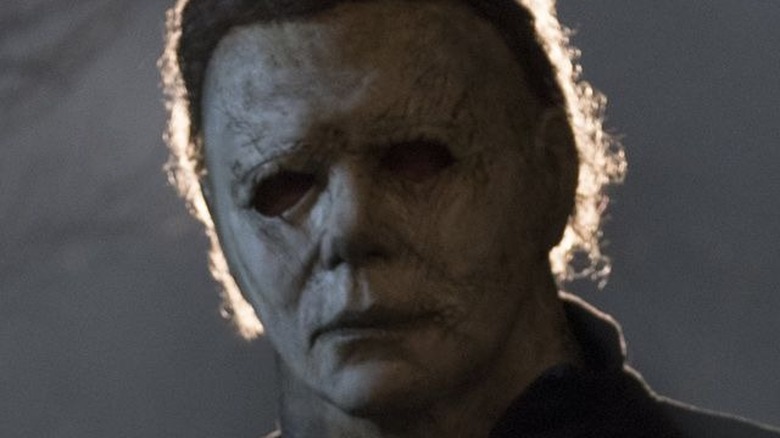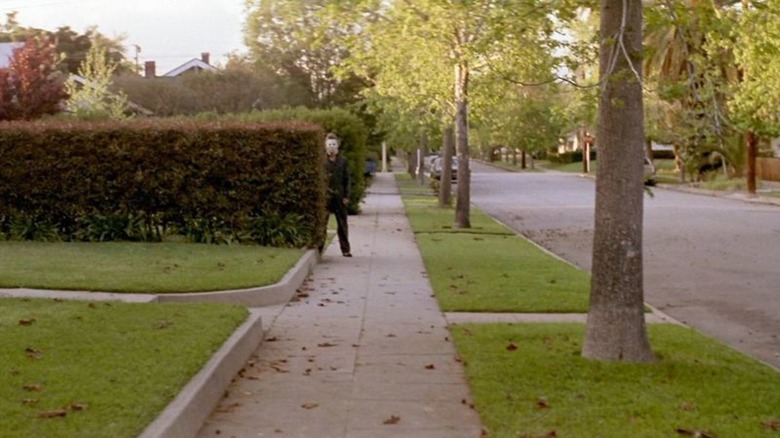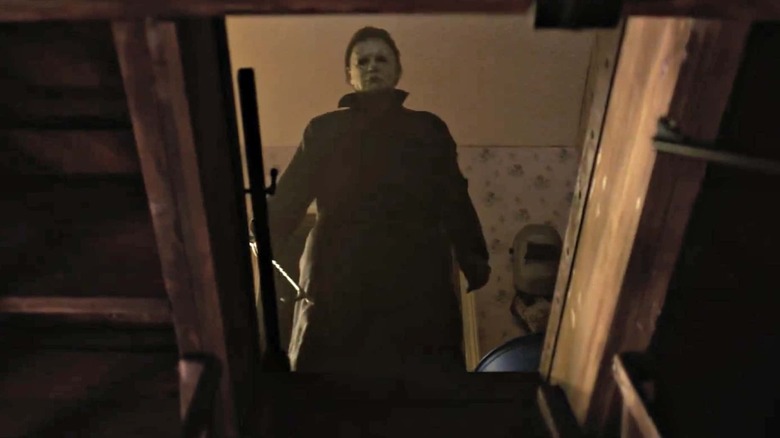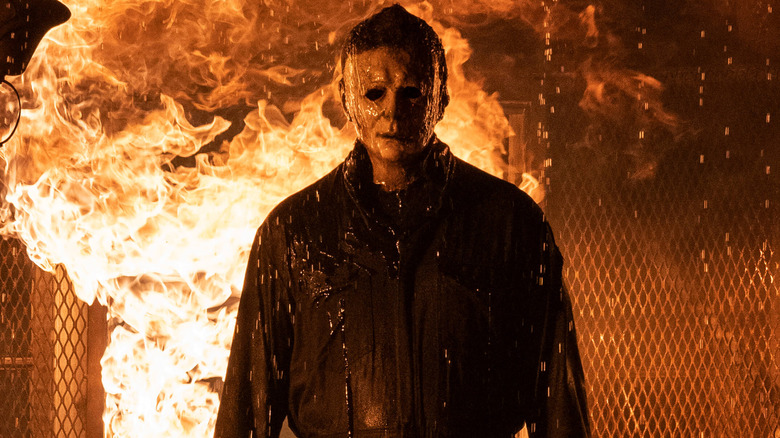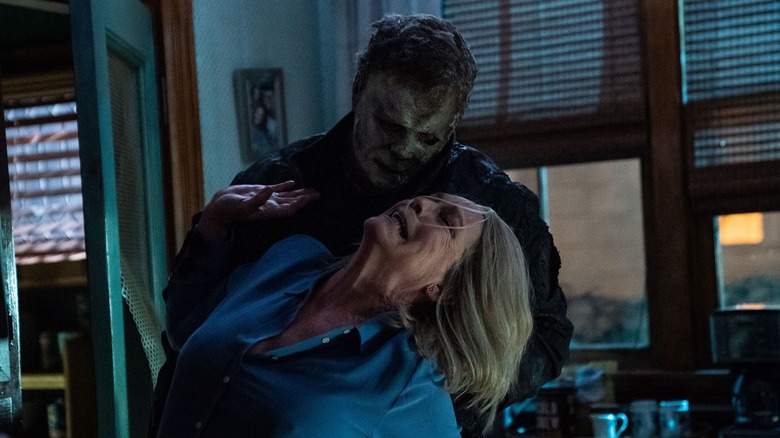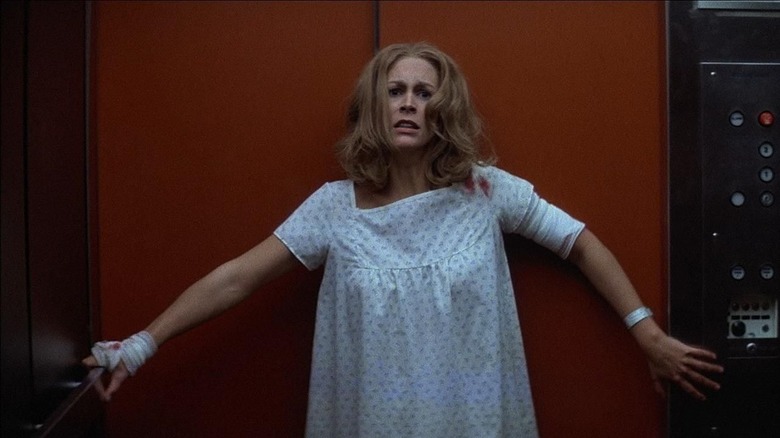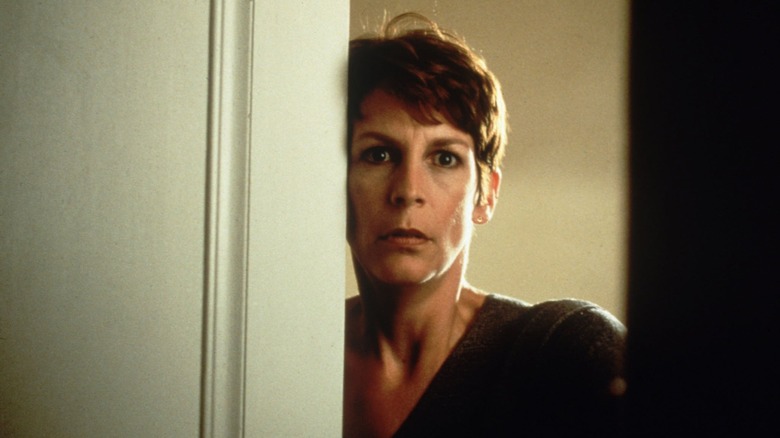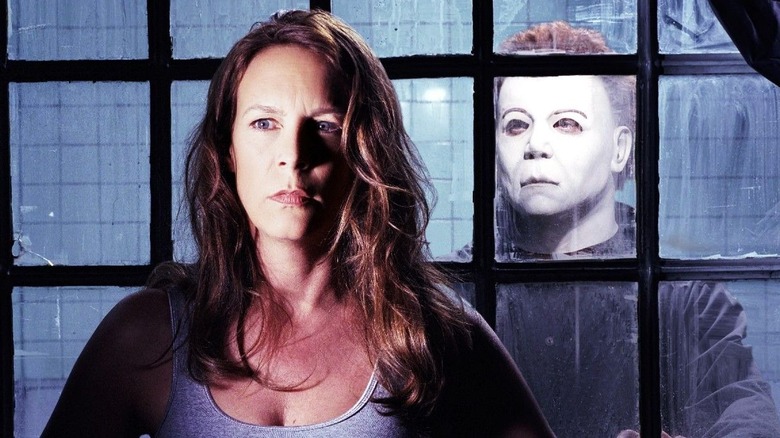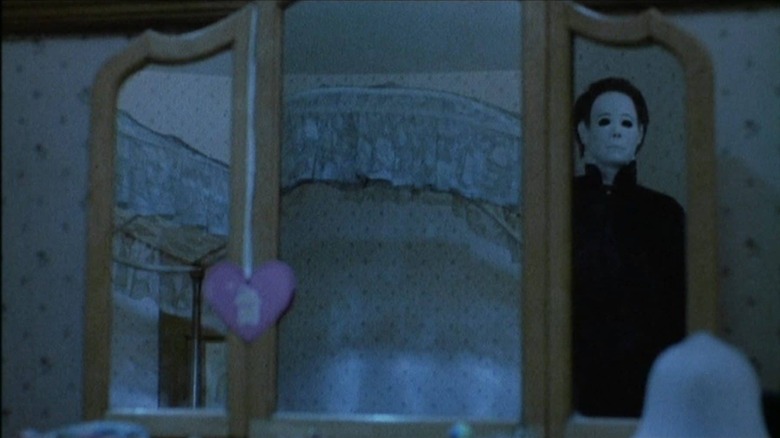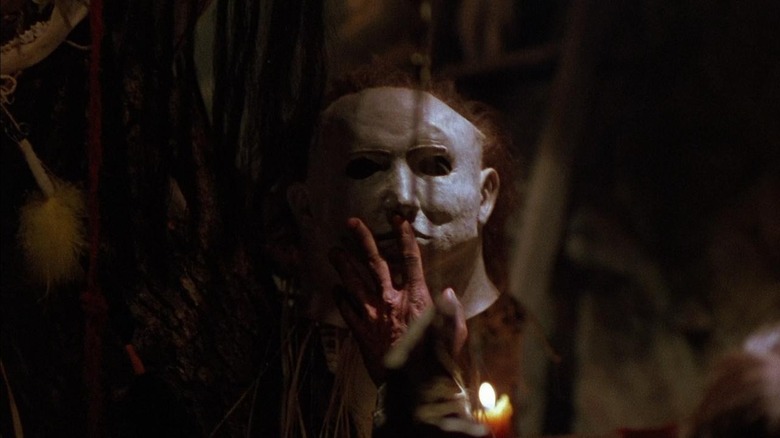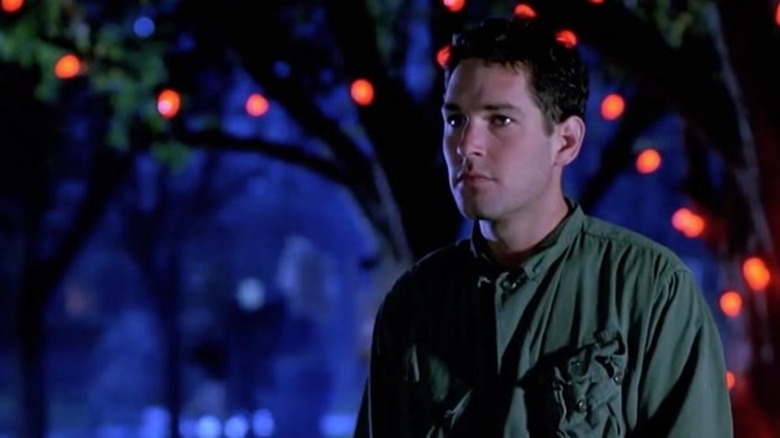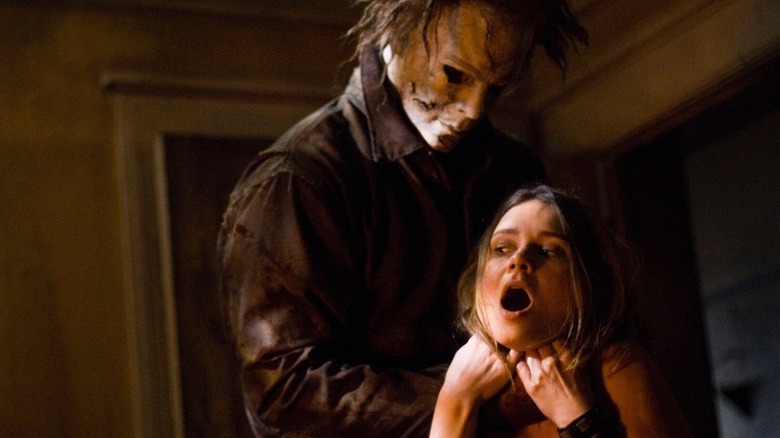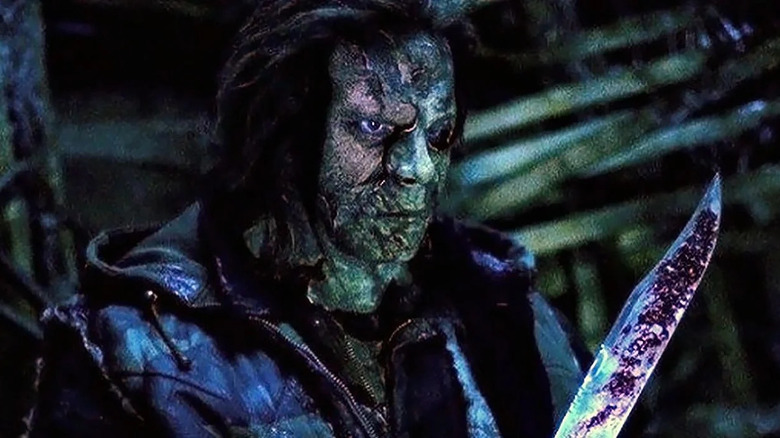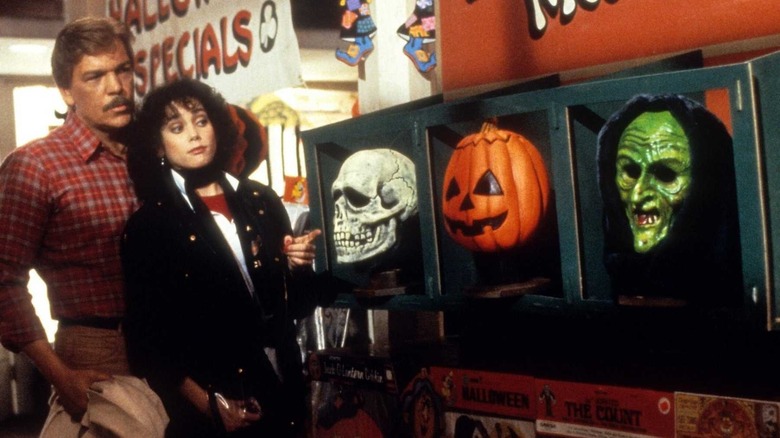The Correct Order In Which To Watch The Halloween Franchise
If you haven't watched all the "Halloween" movies, it can be a daunting series to approach. Not only are there 12 "Halloween" movies so far (with a 13th on the way), they don't comprise a linear series that can be watched one after the other without confusion. There are multiple timelines, sequels that deliberately ignore or erase previous sequels, one full reboot (as opposed to two partial reboots), and one movie that just has nothing at all to do with any of the others. So where do you even start, and what path do you follow?
It might be tempting to approach the movies in the order they were released, but that would actually be a mistake. To get as much enjoyment as possible out of the series, follow the order laid out below, which will present things in the least confusing manner possible. We've done our best to avoid major spoilers, although a few plot details here and there were inevitable.
Halloween (1978)
Whether you're trusting our viewing order or doing something completely different, you have to start at the beginning, with John Carpenter's 1978 classic, the original "Halloween." It's not just the first and best film in this franchise, it's one of the greatest horror films of all time. It might not have technically been the first slasher movie —there was "Black Christmas" in 1974, for example (via Thrillist) — but "Halloween" really nailed down the tropes, perfected the aesthetics, and was such a huge hit that it made slasher films the dominant horror subgenre for the next decade.
At the center of "Halloween" is Laurie Strode (Jamie Lee Curtis), a typical if slightly awkward teenage girl who doesn't have a date for Halloween night. Instead, she has a babysitting gig. Unfortunately for Laurie, and even more unfortunately for her friends, a killer named Michael Myers (Nick Castle) escaped from an institution the day before, and he's stalking the streets of their quiet little town of Haddonfield, Illinois. Carpenter does a great job of slowly building suspense throughout the movie, as Laurie catches little glimpses of Michael from a distance throughout the day. And then once things get going, the violence comes quickly and unrelentingly until the end of the movie.
"Halloween" isn't interested in who Michael Myers is, or why he's a killer — although we do see his first murder in the prologue — and that's to the film's benefit. He's just an evil force, referred to in the script and credits as "The Shape" who exists only to bring death on Halloween night.
Halloween (2018)
Despite having the same title as the original film, 2018's "Halloween" isn't a remake, it's a sequel. It picks up 40 years after the events of the original film, and ignores every sequel that came in between. Those films added a lot of lore and backstory to Haddonfield, Michael Myers, and Laurie Strode. And as the quality of the movies went downhill, the lore became more burdensome. The 2018 movie isn't interested in any of that. Director David Gordon Green, along with his co-screenwriters Jeff Fradley and Danny McBride, strip things down to what made the original film work so well. Michael is nothing more than a wordless harbinger of death, and he's coming for Laurie for reasons that can't be explained.
Forty years after that fateful Halloween night, Laurie Strode has never stopped preparing for the possibility of Michael Myers returning. She has a fraught relationship with her daughter Karen (Judy Greer), who she raised in a survivalist fashion in the hopes of making sure she's more prepared than Laurie was in 1978 to encounter a killer like Michael. Karen now has a teenage daughter of her own, Allyson (Andi Matichak), who mostly just thinks of her grandmother as a weird old lady who never recovered from a teenage trauma. And basically, that's what Laurie is, but when Michael does escape and return to Haddonfield, it turns out grandma was right all along.
Halloween Kills (2021)
"Halloween Kills" picks up immediately after the 2018 film, and reveals Michael Myers to be even harder to kill than previously believed. He escapes from the death trap that Laurie Strode carefully set for him, killing a ridiculous amount of first responders along the way. Meanwhile Laurie, Karen, and Allyson escape to a hospital, while word spreads through Haddonfield that the killer who terrorized the town forty years earlier has returned.
Along the way there are extensive flashbacks to 1978, showing a new take on what happened immediately after the original film, as Michael's Halloween massacre continued. Back in the present, the story catches up with several more characters from the 1978 movie, most notably Tommy Doyle (Anthony Michael Hall), the little boy Laurie was babysitting that night, who still carries some of that trauma inside him. He attempts to rally the townsfolk to hunt Michael down, which goes as badly as attempts at mob justice often do, without ever making the mistake of directing any sympathy toward Michael Myers himself.
"Halloween Kills" ends with something of a cliffhanger, which sets up the upcoming "Halloween Ends," which is meant to finally be the end of the franchise.
Halloween Ends (2022)
"Halloween Ends," the finale of director David Gordon Green's trilogy, is undoubtedly the most controversial of the three films and perhaps the entire franchise. Picking up three years after the events of "Halloween Kills," Laurie Strode and her granddaughter, Allyson, piece together a new life after Michael Myers murdered Karen. Michael has seemingly disappeared, but no one believes he is well and truly gone.
Allyson falls in love with Corey Cunningham (Rohan Campbell), a young man who was involved in an accidental tragedy where the boy he was babysitting died. One evening, a group of bullies throw Cunningham over a bridge, and Michael Myers drags him into the sewers. As Michael strangles him, Cunningham looks into his eyes and sees pure evil. He escapes from Michael's clutches, but he's no longer the same person, as he develops a murderous streak of his own and even teams up with Michael to take down a victims.
"Halloween Ends" is more about the evolution of evil than it is about Michael and Laurie's final encounter. While Cunningham is stopped dead in his tracks and Laurie and Michael have their last dance — which all but indicates Michael is gone for good, unless he can survive the effects of a mechanical shredder — the film takes huge risks with its narrative choices. It received a divisive reception, with publications such as Observer calling it "engaging and suspenseful," while others such as Film School Rejects dubbing it "a dull, wildly miscalculated misfire."
Halloween II (1981)
Now that you've caught up to the present with the most recent films in the franchise, it's time to journey back to a previous timeline. Long before the recent David Gordon Green films, it was 1981's "Halloween II," which continued the story of that original Halloween night in 1978, beginning with the final moments of the original film and then showing the rest of the harrowing night that follows. Traumatized and with minor injuries from her ordeal, Laurie Strode is taken to the local hospital, while the cops search for Michael Myers. What everyone takes way too long to realize, however, is that Michael has followed Laurie to the hospital, where he sets about slaughtering the staff on the way to her bedside.
This next bit is something of a spoiler, but mentioning it is necessary if we're going to continue discussing the franchise beyond this point. "Halloween II" reveals that Laurie Strode is actually Michael Myers' younger sister, who was secretly adopted after the death of their parents. While it's unclear exactly how Michael would know who she is anyway, this is presented as his reason for continuing to stalk her. It's also the biggest bit of lore that's purposefully left out of the 2018 film and its sequel, which choose to build instead on the apparent randomness of the attacks in the first movie.
Halloween H20: 20 Years Later (1998)
"Halloween H20: 20 Years Later" follows up on the events of the first two movies, ignoring the other sequels that had come in between. After all, if you can get Jamie Lee Curtis back, why worry about what happened when she wasn't around? Having faked her death to avoid future attacks from the world's worst brother, Laurie Strode is working as the headmistress of a California boarding school, where her teenage son John (Josh Hartnett) is a student. After most of the students leave for a field trip, only a handful of people are left on campus, which of course is when Michael arrives, having tracked Laurie down. People quickly begin to die, including Laurie's boyfriend will (Adam Arkin), and Laurie comes to realize that the only way to put a stop to this after all these years is to confront Michael Myers directly.
"H20" is far from the most effective movie in the franchise, but Jamie Lee Curtis is always great, and this entry is definitely a step up from the last few that had come before.
Halloween: Resurrection (2002)
"Halloween: Resurrection" is a direct sequel to "H20," but a far inferior film. Jamie Lee Curtis appears again as Laurie, but she's not used nearly as well this time around, and the previous film's "final confrontation" between Laurie and Michael is retconned into something far less satisfying. The main plot involves a group of college students spending the night in Michael Myers' childhood home for an internet-based reality show called "Dangertainment." In an interesting bit of casting, the directors of the show are played by Tyra Banks and Busta Rhymes. Naturally, Michael arrives just in time to start killing people while the cameras are rolling.
If you've ever heard anyone mention the infamous kung fu fight between Michael Myers and Busta Rhymes, obviously this is the movie where that happens, which is probably this movies biggest and most ignoble claim to fame. There's also a bit where Busta dresses up as Michael to provide scares for the show, not realizing the real Michael is also there, which leads to some confusion. Overall, not a great film, but the goal here is to make it through the whole franchise, and in the pursuit of that goal it's time to once again go back in time.
Halloween 4: The Return of Michael Myers (1988)
Now that we've covered all the movies with Jamie Lee Curtis and both of the franchise's partial continuity reboots, it's time to go back and catch up with the original sequels. "Halloween III" was its own thing, which we'll get to eventually, but "Halloween 4: The Return of Michael Myers" was the first movie to follow up on "Halloween 2." As the movie begins, Laurie Strode is dead, and Michael Myers has been comatose for 10 years. He's awakened, however, by a paramedic's loose talk about Laurie having a daughter. Naturally, he escapes with the goal of killing his last living family member.
Laurie's daughter Jamie (Danielle Harris) is living with the Caruthers family, whose teenage daughter Rachel (Ellie Cornell) has the misfortune of babysitting young Jamie on Halloween, which of course is when Uncle Michael shows up to cause chaos. Without the involvement of John Carpenter, "Halloween 4" doesn't really compare to the earlier films in the series, but it does have a surprising twist or two that make it well worth a watch.
Halloween 5: The Revenge of Michael Myers (1989)
Danielle Harris returns as Jamie Lloyd in "Halloween 5: The Revenge of Michael Myers," which picks up (and was actually released) only a year after the previous film. Despite how many times Michael had previously returned from apparent death, this was the first movie in the Myers saga that really leans into supernatural horror, with Jamie exhibiting a strong psychic connection to her uncle, which puts her in a better position than anyone else to stop his ongoing rampage, despite the fact that she's just an emotionally troubled preteen.
Dread Central notes the original plan for "Halloween 5" was to lean even farther into the supernatural, explaining the origins of Michael's invulnerability and why he's compelled to slaughter his family members. However, aside from the psychic connection with Jamie, most of the supernatural elements were ultimately cut, leaving the film more confusing than it was meant to be, specifically because of a mysterious "Man in Black," who appears several times, setting up a payoff that never comes.
Halloween: The Curse of Michael Myers (1995)
The sixth Halloween film is strangely unnumbered, and didn't come out for six years after the previous one, but it actually follows pretty directly from the events of "Halloween 5," picking up on the dropped threads about the supernatural origins of Michael Myers and the identity of the Man in Black. Jamie Lloyd returns, but Danielle Harris doesn't, with J.C. Brandy taking up the role for Jamie's brief appearance in this installment. The main protagonist, however, is Tommy Doyle, this time played as a young adult by Paul Rudd. Ever since his childhood encounter with the killer, Tommy has been trying to figure out what makes Michael tick. Over the course of this film, all of those secrets are finally revealed, but of course Michael also shows up to once again kill as many people as he can.
Unfortunately, this movie isn't very good, and none of the secrets revealed in this movie amount to anything, because this is the last installment before they started rebooting the continuity, and all of the lore is basically erased for future films. Still, you've come this far, so you might as well see how the original run of sequels ended, plus you get to watch what Paul Rudd was up to before he became a star. It was a long journey from here to "Ant-Man."
Halloween (2007)
Five years after "Halloween: Resurrection" frittered away any goodwill that was left after "Halloween H20," the time had come for a total reboot. Rock musician turned filmmaker Rob Zombie was brought in and given free reign to make "Halloween" his own. What he made was a remake that also had elements of a prequel, offering a much more detailed origin for Michael Myers (Tyler Mane) before moving on to tell the story of the Halloween night when he stalks teenage babysitter Laurie Strode (Scout Taylor-Compton) and kills several of her friends.
Whereas David Gordon Green's later films would later do away with the idea of Michael and Laurie being siblings (which wasn't in the original 1978 movie, after all), Zombie leans way into it, showing the infant Laurie in the early scenes of Michael as a child, and focusing on their family connection throughout the film. Their mother, Deborah Myers, also becomes a major character, played by Rob Zombie's wife and muse, Sheri Moon Zombie.
Although 2007's "Halloween" is obviously no match for the 1978 version, Zombie brings enough ideas of his own to the table to keep things interesting, and his grimy aesthetic is an interesting contrast to the early films in the franchise.
Halloween II (2009)
Rob Zombie brought plenty of his own ideas to his version of "Halloween," but when he made his own "Halloween II," he fully departed from the original films and went in his weird, dark direction. A year after the events of the 2009 film, Michael is an aimless drifter while Laurie is still processing her trauma. Then Michael has a vision of his mother (because of course Sheri Moon Zombie was going to return for this movie), who sends him back to Haddonfield to find Laurie again. What happens when they come face to face is something nobody would have expected, and something that never would have happened in the original version of the saga. But along the way, Michael still kills a bunch of people on October 31, because he wouldn't be Michael Myers if he didn't.
Rob Zombie is one of those filmmakers, far more than the legendary John Carpenter, whose work people are either going to enjoy or absolutely hate. That's particularly true with this film, which goes much farther out into Zombie's domain than the previous installment. But whatever you think about these movies, you have to admit that Zombie's "Halloween" is very much its own thing, independent of Carpenter's. And similarly, Scout Taylor-Compton's version of Laurie Strode, as written and directed by Zombie, is a complete departure from the Jamie Lee Curtis version.
Halloween III: Season of the Witch (1982)
That brings us to the end of the stories of Laurie Strode and Michael Myers, of Jamie Lloyd and Tommy Doyle, and of the town of Haddonfield, Illinois. But strangely enough, there's still one "Halloween" movie left to watch.
"Halloween III: Season of the Witch" has no connections to the rest of the franchise, other than the titular holiday around which it revolves. As far as John Carpenter was concerned, the Michael Myers story ended in 1981 with "Halloween II," and he hoped the series could become an anthology of seasonal horror films with new characters and plotlines in each installment. So Carpenter produced "Halloween III," with Tommy Lee Wallace writing and directing.
"Season of the Witch" stars horror icon Tom Atkins as a troubled doctor who uncovers a nefarious and far-reaching plot involving Halloween masks, androids, and of course witchcraft. It's actually a very good horror movie, but audiences were confused and upset by the lack of Michael Myers, and "Halloween III" didn't perform as well as its predecessors. So the anthology plan was abandoned, and five years later came the aptly titled "Halloween 4: The Return of Michael Myers."
In more recent years, however, this black sheep of the "Halloween" franchise has become something of a cult classic in its own right. And of course, you haven't really watched the entire Halloween franchise until you've seen it. Once you have, there's nothing more for you to learn here, at least until "Halloween Ends" comes out in 2022.
